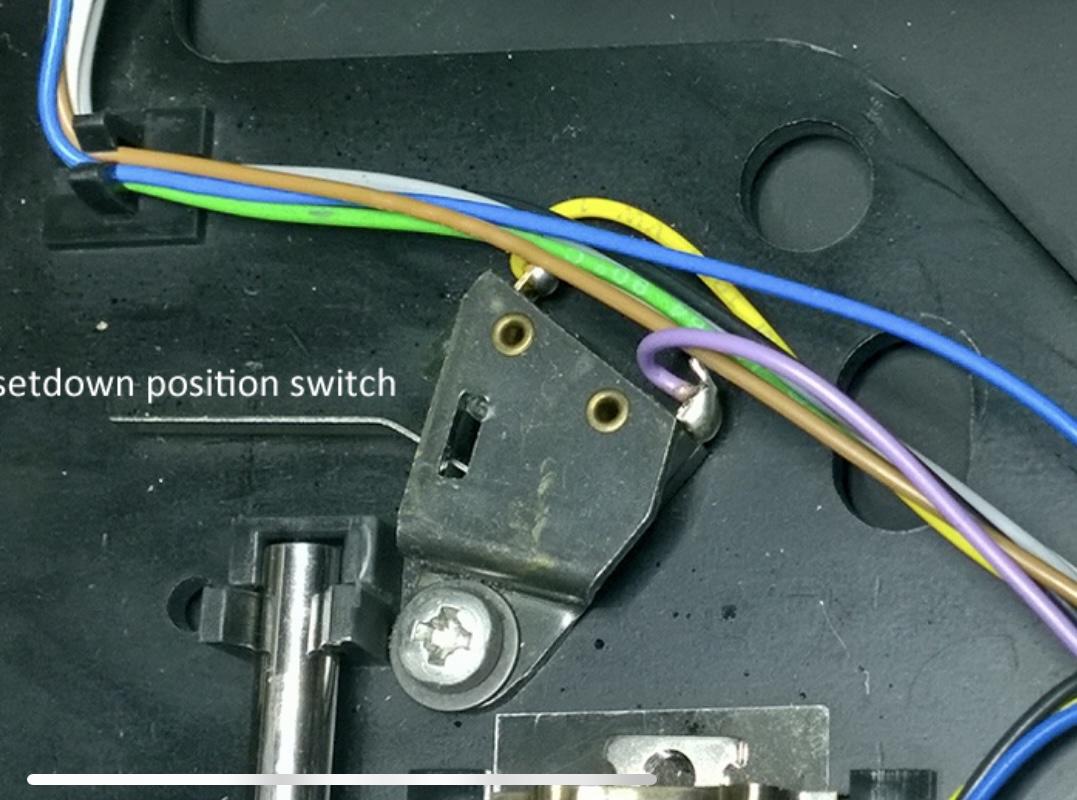Forum Replies Created
-
AuthorPosts
-
I have not observed your problem, but would approach troubleshooting to understand which circuit is at fault as it could also be the record detection section. TR4 and 5 are simply switches so they do not need to be matched. Check the action of the mute switch and check whether it is unmuting or staying muted as it transitions from lowering to raising. I would also check how it behaves with a 45 and without a record at all. Finally, I would monitor the base of TR% to see whether it is causing the arm to raise immediately. Report back with these results and I may be able to recommend either a fix or further testing.
I too have that set and do not experience any problem. If you do not switch the speed and treat is as a 33 record, does it set down correctly? If it does, then I believe it’s a power supply issue with the higher current or faster rotation causing the detection circuit to malfunction. You can confirm this by using your 185 gr 33 record and switching the speed in the same way you did with the 45.
It can be several items, depending on what you are specifically observing. Most of the time, if you hear the muting relay immediately but not the normal solenoid sound, it can be the horizontal or vertical pivots for the cueing mechanism gumming up and not moving easily. It can also be a residual magnetic buildup in the solenoid. This can be handled with a tapehead demagnetizer. If you hear the solenoid but the arm is lagging, this can be because the return spring has weakened, the damper cylinder is not moving smoothly or adjusted properly, or the vertical pivot is gummed up.
The arm does not “see” the record when it gets to the drop point. This is controled by a black line on clear plastic guide attached to the arm transport. This guide can be adjested left and right to correct the set-down point for 12″ records though you need to remove the top plates. As to why it works on 33s bot not that 45, have you seen this occur on any other records? How does its thickness compare to your 33s? There is something about it that is causing the light bouncing from the record to pulse telling the arm that there is no record there. It is possible that the sensor circuit is mis-adjusted and the service manual describes the procedure but you do need test equiopment. One final possiblity is that your power supply has bad electrolytic capacitors that is causing a ripple in the voltage feeding the lamp and so the lamp is pulsing. If the 45 record is of different thickness or reflectivity, this could explain why it only happens on that one.
I’m not sure what behavior you are describing. The turntable only detects a 45 record by virtue of it “seeing” the smaller diameter by receiving optical pulses from the ribs until the edge of the 45 is reached. Just prior to that a black line on the clear plastic mounted to the arm transport causes the speed to switch to 45. If you put a 45 12” record on the turntable should behave as if it’s a 33 LP and simply set down on the edge. You have to manually switch to 45 speed. Please describe what happens if you simply put the 45 LP on as if its is a 33 and change the speed right when or shortly after it lowers. If it is not lowering but continuing on, is your LP a colored vinyl that is partially transparent. This can cause it to not drop but is normal. Simply stop the arm with the > control and use the cuing to manually lower.
You can get an extractor tool cheaply. – i.e. https://a.co/d/j3yLCnU. If you are trying to terminate the wires with new pins, that requires a special crimp tool and new pins and housings are available in kits.
Yes you do unless the powered speakers have a dedicated phono input.
This depends on your version. If it has the RIAA preamp, then it is pin 7. If not and you plug in into the Phono input of your receiver, it is pin 6.
Yes, I have all 7 pins. The switch under the front panel PLAY button was very corroded. I cleaned it but it is falling apart, and I can’t seem to position it correctly for it to work when I press the PLAY front. After fiddling with it for hours, I have decided to accept that it doesn’t work. Can I replace it with another type of tactile switch? It seems to be a rather cheaply made board where a piece of tape was holding the metal plate in place. Any suggestions?
It is simply a piece of conductive spring metal that should be able to be cleaned if desoldered. You could switch it with for example the 45-speed one if its damaged. A pushbutton microswitch such as one of these should be able to be retrofitted with minor board modifications, though I have not personally tried it.
Do you have pins 6 and 7 in the phono cable DIN plug? Those can be missing as they screw in and are needed for datalink communications such as turning on your receiver.
Observing from the front and comparing to a clockface:
12 = L
3 = R
6 = LG
9 = RG
You will need to use an ohm meter to identify which wire is connected to which pin.
If you lost all power (no lights or movement) then it is possible that you blew a fuse. These are under a screwed cover in the back left corent accessible from the top. Having said that, the fuse likely blew for a reason. That table is 40 years old and likely needs its electrolytic caps replaced. There are service kits available such as this one from beoparts-shop.com. You do need soldering skills.
You are missing the set-down switch which those wires connect to. See this picture.
I would also disconnect the cartridge signal cables from the RIAA board and check the resistance between the two signal wires of both channels. Depending on cartridge it should be between 800 and 1K ohms. If it’s open or shorted you’ve got a bad cartridge.
No it is not normal and indicates that your phono preamp does not have sufficient gain or there is an issue with it. You did not indicate what cartridge you are using as the MMC6000 has a lower output for example. It would also help if you had a link to the specs of your preamp that specified its gain. Alternatively, I would try to test the turntable into another receiver to see if you have the same issue.
The arm that has the N and R eccentric is marked as 1606 in the service manual. The problem with the diagram is it leaves out identifying details. That a look at the exploded parts view. As to the platters there were two – one with printed spokes and one with rings.
Yes, that capacitor is important as chassis ground and signal ground must not be tied together in the turntable.
Can you take the back right square cover off by sliding the trim forward and snap a picture of that entire area? It’s possible the chassis ground is not properly connected. Also if you remove the cartridge, you should see a small flexible copper tang coming out of the bottom of the black connector. This connection is designed to ground the body of the cartridge since moving iron cartridges with their relatively low outputs are susceptible to hum. If that was damaged or missing that could also be your problem. Here is a link to a picture of the cartridge holder. If you have an ohm meter with the stylus cover on but the arm lowered, you should have continuity {<1 Ohm) between you ground wire and the cartridge shell.
That type of hum is likely a grounding issue. You did not say what the turntable is connected to. If you are using the DIN->RCA adpater then it must be the phono one which has a separate ground wire or you will get hum. If you are going DIN->DIN it may be a bad chassis ground connection in the TT or amp.
The servo should not activate as the arm is lowering. It sounds like the tonearm needs tracking adjustment. Follow the procedure in the service manual.
-
AuthorPosts


